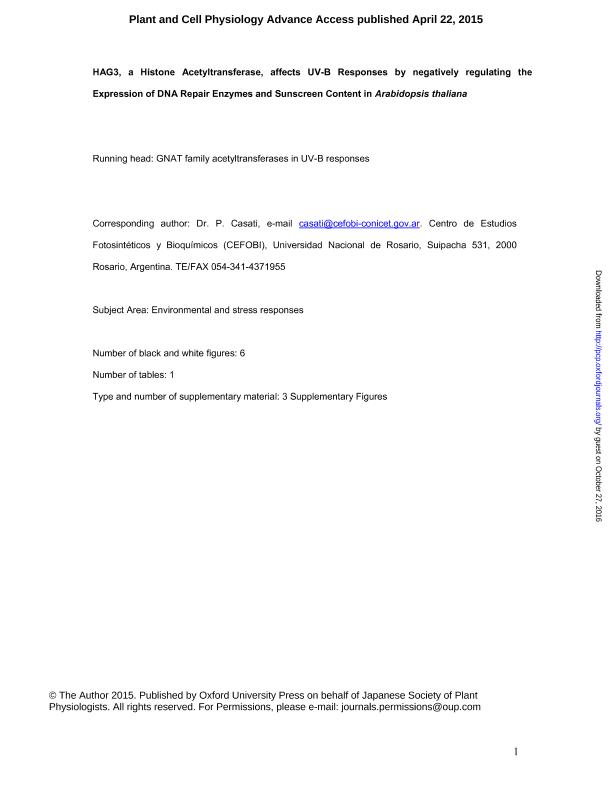Artículo
HAG3, a Histone Acetyltransferase, Affects UV-B Responses by Negatively Regulating the Expression of DNA Repair Enzymes and Sunscreen Content in Arabidopsis thaliana
Fecha de publicación:
04/2015
Editorial:
Oxford University Press
Revista:
Plant And Cell Physiology
ISSN:
0032-0781
Idioma:
Inglés
Tipo de recurso:
Artículo publicado
Clasificación temática:
Resumen
Histone acetylation is regulated by histone acetyltransferases and deacetylases. In Arabidopsis, there are 12 histone acetyltransferases and 18 deacetylases. Histone acetyltransferases are organized in four families: the GNAT/HAG, the MYST, the p300/CBP and the TAFII250 families. Previously, we demonstrated that Arabidopsis mutants in the two members of the MYST acetyltransferase family show increased DNA damage after UV-B irradiation. To investigate further the role of other histone acetyltransferases in UV-B responses, a putative role for enzymes of the GNAT family, HAG1, HAG2 and HAG3, was analyzed. HAG transcripts are not UV-B regulated; however, hag3 RNA interference (RNAi) transgenic plants show a lower inhibition of leaf and root growth by UV-B, higher levels of UV-B-absorbing compounds and less UV-Binduced DNA damage than Wassilewskija (Ws) plants, while hag1 RNAi transgenic plants and hag2 mutants do not show significant differences from wild-type plants. Transcripts for UV-B-regulated genes are highly expressed under control conditions in the absence of UV-B in hag3 RNAi transgenic plants, suggesting that the higher UV-B tolerance may be due to increased levels of proteins that participate in UV-B responses. Together, our data provide evidence that HAG3, directly or indirectly, participates in UV-B-induced DNA damage repair and signaling.
Palabras clave:
Uv-B Radiation
,
Acetylation
,
Hag3
,
Histone Acetyltransferase
Archivos asociados
Licencia
Identificadores
Colecciones
Articulos(CEFOBI)
Articulos de CENTRO DE EST.FOTOSINTETICOS Y BIOQUIMICOS (I)
Articulos de CENTRO DE EST.FOTOSINTETICOS Y BIOQUIMICOS (I)
Citación
Fina, Julieta Paola; Casati, Paula; HAG3, a Histone Acetyltransferase, Affects UV-B Responses by Negatively Regulating the Expression of DNA Repair Enzymes and Sunscreen Content in Arabidopsis thaliana; Oxford University Press; Plant And Cell Physiology; 56; 7; 4-2015; 1388-1400
Compartir
Altmétricas




